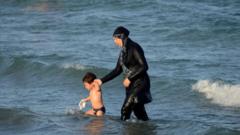Recent satellite imagery reveals that Russian naval vessels have vacated their Tartous naval base in Syria, raising questions about the country's military strategy following the fall of its ally, Bashar al-Assad.
Russian Naval Fleet Leaves Syrian Base Amid Uncertainty About Future Operations

Russian Naval Fleet Leaves Syrian Base Amid Uncertainty About Future Operations
Tartous naval facility remains vital for Russian military presence in the Mediterranean as Moscow reassesses its strategy.
In a significant development regarding Russian military operations in Syria, satellite images from December 10 indicate a temporary withdrawal of Russian naval vessels from the Tartous naval base. This facility has long served as a cornerstone of Russian naval power in the Mediterranean. The analysis, conducted by BBC Verify, shows that while some ships are now stationed offshore, other military activities continue unabated at the Khmeimim airbase, Russia's primary aerial facility in Syria.
Kremlin officials acknowledged the precarious situation, with spokesperson Dmitry Peskov confirming ongoing discussions regarding Russia's military presence in the country. He emphasized the need for secure communication with current authority figures in Syria as well as measures to safeguard military assets. “Everything possible is now being done to get in touch with those involved in ensuring security... ensuring the safety and security of our facilities are of utmost importance,” Peskov stated.
The Tartous naval base, a significant repair and replenishment depot for Russia’s Black Sea Fleet, was originally established by the Soviet Union and has been crucial since Moscow’s increased support for Assad's regime in recent years. Furthermore, this facility's deep-water capabilities allow hosting of submarines, increasing Russia's naval capabilities in the region.
Recent satellite observations show two guided missile frigates currently stationed about 8 miles off the Syrian coast, but the whereabouts of the larger fleet remain unclear. Military analysts suggest this movement might be a precautionary measure against potential attacks, possibly from Syrian rebels or Israeli operations targeting Syrian assets.
Frederik Van Lokeren, an analyst and former Belgian navy captain, commented on the situation, saying that the Russian fleet appears to be “in limbo” while Moscow strategizes its next steps, indicating the possibility of negotiations with regional allies regarding the vessels' redeployment.
In light of potential future adjustments, speculations have arisen regarding the relocation of Russian naval assets to Tobruk, Libya, which is under the control of Kremlin-backed Field Marshal Khalifa Haftar. However, a withdrawal from Tartous would bring significant costs, particularly as it would place Russian vessels closer to NATO monitoring sites.
While the naval developments are noteworthy, the Khmeimim airbase remains operational, with active aircraft visible on site. Observations indicate that fewer assets are present compared to the heavy involvement seen in 2015, pointing to a current status of readiness rather than immediate evacuation.
Amidst these tensions, the fall of the Assad regime signifies a significant challenge to Russia's strategic ambitions in the region, compelling a reassessment of long-term military goals. Influential voices within Russia, like pro-Kremlin military bloggers, underscore the fragile state of Russia’s influence in the Middle East, describing the situation as "hanging by a thread."
Kremlin officials acknowledged the precarious situation, with spokesperson Dmitry Peskov confirming ongoing discussions regarding Russia's military presence in the country. He emphasized the need for secure communication with current authority figures in Syria as well as measures to safeguard military assets. “Everything possible is now being done to get in touch with those involved in ensuring security... ensuring the safety and security of our facilities are of utmost importance,” Peskov stated.
The Tartous naval base, a significant repair and replenishment depot for Russia’s Black Sea Fleet, was originally established by the Soviet Union and has been crucial since Moscow’s increased support for Assad's regime in recent years. Furthermore, this facility's deep-water capabilities allow hosting of submarines, increasing Russia's naval capabilities in the region.
Recent satellite observations show two guided missile frigates currently stationed about 8 miles off the Syrian coast, but the whereabouts of the larger fleet remain unclear. Military analysts suggest this movement might be a precautionary measure against potential attacks, possibly from Syrian rebels or Israeli operations targeting Syrian assets.
Frederik Van Lokeren, an analyst and former Belgian navy captain, commented on the situation, saying that the Russian fleet appears to be “in limbo” while Moscow strategizes its next steps, indicating the possibility of negotiations with regional allies regarding the vessels' redeployment.
In light of potential future adjustments, speculations have arisen regarding the relocation of Russian naval assets to Tobruk, Libya, which is under the control of Kremlin-backed Field Marshal Khalifa Haftar. However, a withdrawal from Tartous would bring significant costs, particularly as it would place Russian vessels closer to NATO monitoring sites.
While the naval developments are noteworthy, the Khmeimim airbase remains operational, with active aircraft visible on site. Observations indicate that fewer assets are present compared to the heavy involvement seen in 2015, pointing to a current status of readiness rather than immediate evacuation.
Amidst these tensions, the fall of the Assad regime signifies a significant challenge to Russia's strategic ambitions in the region, compelling a reassessment of long-term military goals. Influential voices within Russia, like pro-Kremlin military bloggers, underscore the fragile state of Russia’s influence in the Middle East, describing the situation as "hanging by a thread."





















